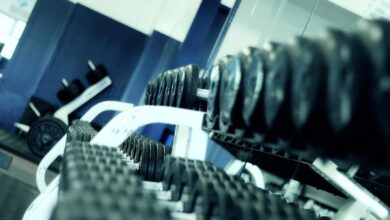Unlock Explosive Power: The Ultimate Guide to Plyometric Training for Peak Performance

In the world of fitness and athletic training, developing explosive power can often be the difference between good and exceptional performance. Plyometric training, also known as jump training, is a proven method to enhance this explosive power. This article will delve into understanding plyometrics, its benefits, and how to incorporate it into your training routine for peak performance.
What Is Plyometric Training?
Plyometric training involves exercises that exert maximum force in short intervals of time, with the ultimate goal of increasing power (speed-strength). These exercises typically involve a stretch-shortening cycle, meaning muscles rapidly lengthen (eccentric phase) and then shorten (concentric phase).
Common plyometric exercises include:
- Jump Squats
- Box Jumps
- Burpees
- Clap Push-Ups
- Tuck Jumps
These exercises train the fast-twitch muscle fibers, or type II fibers, which are responsible for quick, explosive movements.
The Science Behind Plyometrics
Plyometrics hinges on the stretch-shortening cycle (SSC) which has three phases:
- Eccentric Phase: The muscle lengthens under tension.
- Amortization Phase: This is the transition period between eccentric and concentric phases—critical for maximizing power.
- Concentric Phase: The muscle shortens and generates force.
During the eccentric phase, elastic energy is stored in the muscles and tendons. When followed by an immediate concentric contraction, this stored energy is released, resulting in a powerful movement. This cycle improves not only muscle strength but also neuromuscular efficiency.
Benefits of Plyometric Training
Enhanced Athletic Performance
Plyometrics is particularly beneficial for sports that require sudden bursts of energy like basketball, soccer, and track and field events. Improved power translates to better sprinting speed, higher jumps, and quicker directional changes.
Increased Muscle Strength
Plyometrics doesn’t just enhance power; it also increases muscular strength. By subjecting your muscles to high levels of force in a minimal amount of time, you’re effectively challenging them to adapt and grow stronger.
Improved Balance and Coordination
Many plyometric exercises require a high level of coordination and balance, engaging multiple muscle groups simultaneously. This not only helps in athletic performance but also reduces the risk of injuries by stabilizing the joints and improving proprioception (awareness of body position).
Efficient Caloric Burn
High-intensity plyometric exercises elevate your heart rate, providing an excellent cardiovascular workout that burns calories efficiently. This is particularly beneficial for those aiming to lose weight or improve cardiovascular health.
Enhanced Metabolic Rate
The intense nature of plyometric exercises can boost your metabolic rate even after the workout, thanks to the afterburn effect (EPOC – Excess Post-Exercise Oxygen Consumption). This means you’ll continue burning calories post-training.
Incorporating Plyometrics into Your Training Routine
Before diving into plyometric training, it’s essential to establish a base level of strength and conditioning to prevent injuries. Follow these guidelines to incorporate plyometrics safely and effectively.
Warm-Up and Stretching
A thorough warm-up prepares your muscles and joints for the high-intensity exercises ahead. Include dynamic stretches such as high knees, leg swings, and lunges to increase blood flow and flexibility.
Start with Low-Impact Exercises
Begin with low-intensity plyometric exercises like jump ropes or mini-trampoline activities, gradually advancing to more complex movements as your strength and coordination improve.
Focus on Form and Technique
Proper form is crucial in plyometric training to maximize performance and minimize injury risk. Keep your core engaged, land softly with bent knees, and maintain good posture throughout each movement.
Progressive Overload
To continuously challenge your muscles and improve performance, progressively increase the intensity and complexity of your exercises. Add more repetitions, higher jumps, or incorporate weights for added resistance.
Recovery and Rest
Plyometric training is intense and can be taxing on your muscles and joints. Allow adequate recovery between sessions to prevent overuse injuries. Typically, 48-72 hours between plyometric workouts is advisable.
Sample Plyometric Workout Routine
Here’s a sample beginner-level plyometric workout to get you started:
Warm-Up (5-10 minutes)
- Dynamic Stretching: High knees, butt kicks, walking lunges
- Jump Ropes: 2 minutes
Main Workout (3 sets each, 60-second rest between sets)
- Jump Squats: 12-15 reps
- Box Jumps: 10 reps
- Lateral Bounds: 12 reps per side
- Burpees: 10-12 reps
- Tuck Jumps: 10-12 reps
Cool-Down (5-10 minutes)
- Static Stretching: Focus on leg muscles, hip flexors, and back
- Foam Rolling: To relieve muscle tightness and soreness
Safety Considerations
Individual Fitness Level
Tailor the intensity and duration of plyometric exercises to match your fitness level. If you’re new to exercise or have any pre-existing medical conditions, consult a fitness professional or healthcare provider before starting plyometric training.
Proper Footwear
Wear supportive, well-cushioned shoes to absorb impact and reduce stress on your joints.
Surface and Environment
Perform plyometric exercises on a soft, flat surface to minimize the impact on your joints. Avoid hard surfaces like concrete which can increase injury risk.
Recommended equipment
Conclusion
Plyometric training is a powerful, efficient way to unlock explosive power and elevate your athletic performance. By incorporating it into your regular fitness routine, you can achieve remarkable gains in strength, speed, balance, and coordination. Remember to start slow, focus on form, and progress gradually for the safest and most effective results. Unleash your potential and take your performance to the next level with plyometric training.




